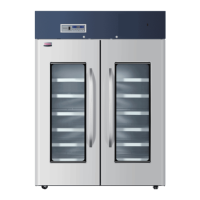25
4
Do not climb on or place articles on the refrigerator as personal injuries or refrigerator
damage may be caused due to turnover of refrigerator.
Do not plug metal articles such as iron nails or wires into the holes and gaps or vents
for internal air circulation, to prevent electric shock or personal injuries due to contact
of articles above with moving parts.
Do not place containers with water or heavy stuffs on the refrigerator. Personal injuries
may be caused by falling articles and electrical leakage or shock may be caused by out
flowed water due to deterioration of insulation.
Do not ground the refrigerator through gas pipes, water supply pipes, telephone lines or
lightning conductors as electric shock or other dangers may be caused.
Do not touch electrical parts such as power plug or switches with wet hands to prevent
electric shock.
Hold the power plug rather than the wire when pulling the plug from the socket as electric
shock or fire due to short circuit may be caused.
Pull out the power plug when the refrigerator is under abnormal performance as electric
shock or fire may be caused.
Users are not allowed to dismantle, repair or refit the refrigerator by themselves as fire
or personal injuries may be caused due to improper operation.
Disconnect the refrigerator when repairs or maintenance are performed on the refrigerator
to prevent electric shock or personal injuries.
Make sure medicines or airborne particles inside or around the refrigerator will be not be
inhaled during maintenance as health hazard may be caused.
The refrigerator shall be used in safe regions when toxic, harmful or radioactive articles
are stored inside, as improper use may pose danger to human health or environment.
Pull out the power plug if the refrigerator has been out of service for long time to prevent
electric shock, leakage or fire caused by aging power lines.
If the refrigerator is left unused in areas where supervision is unavailable for a long time,
make sure children will not get close to the refrigerator and the door can not be
completely closed.
End-of-life disposal shall be performed by competent staffs. Remove the door to prevent
accidents such as suffocation.
Do not store explosive substances such as aerosol cans with a flammbale propellant in
this appliance.
Do not store corrosive articles such as acid or alkali in the refrigerator to prevent damage
to internal components or electrical parts.
Do not place packaging plastic bags within the reach of children to prevent suffocation
accidents.
Circuit diagram
CN2
1
L
N
2
L
N
t
GND
+12V
L
N
t
1
L
N
2
L
N
Power panel
Power line
L
N
E
Condensate fan
Compressor
Defrosting heating strip
Main control panel
Internal fan
Display panel
Sensor
Defrosting
Control
Lower temperature
Upper temperature
Alarm
VCC
GND
Heating strip at the cabinet outlet
Heating strip of center sill
Door heating transformer
Door heating strip 1
LED drive model
Lamp switch
USB drive panel
USB port
Reserved network interface
Wiring terminal 2
Double-throw switch
Press wiring terminal box
Power line terminal box
Connection to electric
control cabinet enclosure
Door heating strip 2
Door heating transformer
Wiring terminal 1
Battery switch
Wiring terminal 3
Connection to electric
control cabinet enclosure
Remote alarm port
Filter
High temperature
prevention
thermostat
C
H
L
J5
CN2
N
L
CN1
NO
COM
NC
CN2
CN1
CN7
CN6
CN5
NO
COM
NC
CN1
CN2
CN11
16V
BAT-
BAT+
BT1
GND
CN3
CN1
GND
16V
CN3
FAN
L
N
K2
K3
NC
NC
COM
COM
NO
NO
HTR
Door switch
door
Terminal connected to the
refrigerator’s upper board

